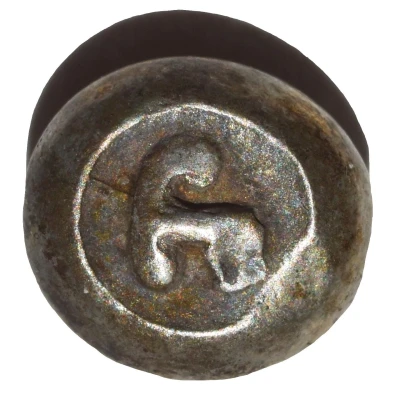


© Timbrimi
1 Masa ND
| Silver | 2.41 g | 12.2 mm |
| Issuer | Pre-Islamic kingdoms (Indonesia) |
|---|---|
| Type | Standard circulation coin |
| Years | 800-1300 |
| Value | 1 Māsa |
| Composition | Silver |
| Weight | 2.41 g |
| Diameter | 12.2 mm |
| Thickness | 2.9 mm |
| Shape | Round (irregular) |
| Orientation | Coin alignment ↑↓ |
| Demonetized | Yes |
| Updated | 2024-10-05 |
| Numista | N#223762 |
|---|---|
| Rarity index | 72% |
Reverse
Incuse square and a four petaled flower design identified as the Sandalwood flower (genus Santalum).
Edge
Plain
Comment
Silver coinage used in the Malay archipelago between the ninth to thirteenth centuries. Presumably first developed in Java during the Śailendra period before spreading to various locations such as Sumatra and Malay Peninsula. Commonly referred in literature as "sandalwood flower coins" based its reverse design, or "mā coins" based on its observe design. Often inaccurately referred as Majapahit coin, even though common use of this coin predates the founding of Majapahit empire in AD 1293. By the fourteenth century, cash transactions in Majapahit had actually transitioned to Chinese cash coins (Wicks 1986: 44-47, 50-55)Early specimens are flat and thick. Later coins are broader with a noticeable convexity. These coins was part of a system used in classical Java and Bali with ideal weight and unit reconstructed as follow (Wicks 1986: 45, 59) (Christie 1996: 257-260):
1 kaṭi (608.96 g) = 16 suvarṇa / tahil
1 suvarṇa / tahil (38.06 g) = 16 māṣa
1 māṣa (2.412 g) = 4 kupang
1 kupang (0.603 g)
In Old Javanese inscriptions, these units are invariably abbreviated as ka, su/ta, mā, and ku. The latest inscription that referred to these units is from AD 1296 AD.
See:
Christie, Jan Wisseman (1996) "Money and Its Uses in the Javanese States of the Ninth to Fifteenth Centuries A.D."
Millies, Henricus Christiaan (1871). Recherches sur les monnaies des indigènes de l'archipel Indien et de la pèninsule Malaie https://archive.org/details/recherchessurles00mill_0 plate I
Wicks, R. S. (1986). "Monetary Developments in Java between the Ninth and Sixteenth Centuries: A Numismatic Perspective" https://doi.org/10.2307/3351187, pp: 42–77.
Interesting fact
One interesting fact about the Standard circulation coin 1 Masa ND (800-1300) from Pre-Islamic kingdoms (Indonesia) made of Silver weighing 2.41 g is that it features a unique blend of Hindu-Buddhist and local Indonesian elements in its design. The coin's obverse side bears an image of a Hindu deity, while the reverse side features a stylized representation of a rice grain, which was a significant crop in ancient Indonesia. This blending of cultural influences reflects the rich cultural heritage of the region and highlights the importance of trade and cultural exchange in shaping the history of Indonesia.



